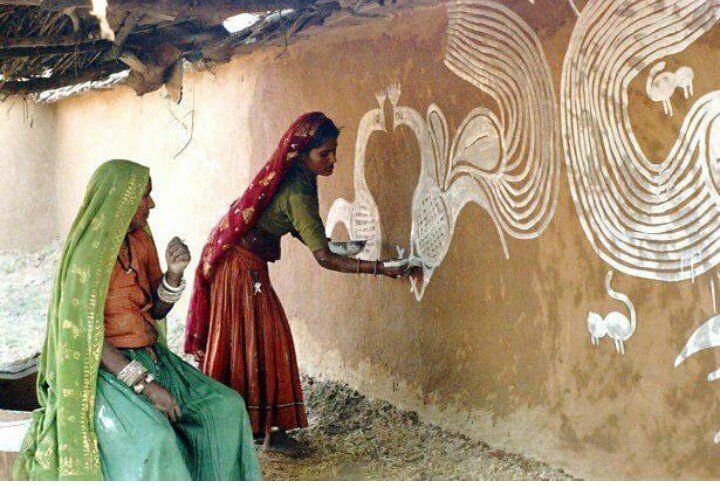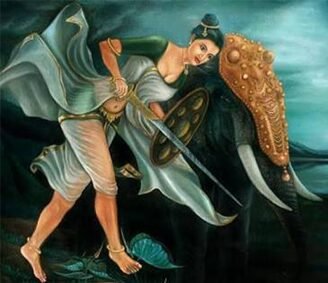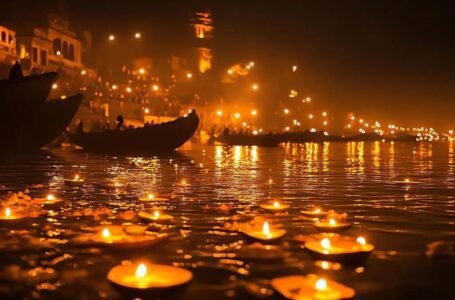Mandana Painting: The Fading Legacy of Traditional Home Décor Art in Rajasthan and Madhya Pradesh

Mandana painting is a beautiful and ancient folk art form from Rajasthan and Madhya Pradesh, deeply woven into the cultural fabric of these regions. Traditionally created by rural women, these paintings adorn floors and walls with intricate geometric patterns, floral designs, and depictions of animals, birds, and deities. The process is simple yet striking—white chalk (lime or khadiya) and red ochre (geru) are used to create visually stunning contrasts. More than just decoration, Mandana paintings are believed to bring good luck and are an essential part of festivals, rituals, and special occasions.
However, this centuries-old tradition is fading fast. With changing lifestyles, modern homes replacing mud walls, and younger generations moving away from traditional arts, Mandana painting is struggling to survive. Despite its deep cultural roots, this exquisite art form is now at risk of disappearing.
The word “Mandana” comes from the Sanskrit term Mandan, which means decoration. This traditional art has been passed down through generations, deeply rooted in the tribal and rural communities of Rajasthan and Madhya Pradesh. Some believe it has been around for over a thousand years, tracing its origins to ancient Indian civilizations where floor and wall paintings were common.
Mandana paintings weren’t just about beautifying homes—they held deep cultural and spiritual significance. People created them to seek divine blessings, ward off evil spirits, and bring prosperity. Women, in particular, played a crucial role in keeping this art alive, passing it down through oral traditions and hands-on practice. Over time, Mandana became an essential part of the cultural identity of regions like Shekhawati, Hadoti, Malwa, and Nimad, each adding its own unique touch to the tradition.
Creating a Mandana painting takes patience, skill, and a deep connection to tradition. It all starts with preparing the surface—whether it’s a mud wall or a courtyard floor—by cleaning it thoroughly and then coating it with a mixture of cow dung and red ochre (geru). This not only creates a striking contrast for the white patterns but also acts as a natural disinfectant, a practice that has been followed for generations.
Once the base is ready, the real artistry begins. Using a white paste made from chalk powder or rice flour mixed with water, intricate patterns start to take shape. Unlike modern painting methods, Mandana designs are not created with brushes. Instead, women use their fingers, twigs, or cotton swabs, giving the artwork an organic, handmade feel. The complexity of the design depends on the occasion—some are simple and repetitive, while others are incredibly detailed, taking days to complete.
Mandana paintings are rich in symbolism, with each motif carrying a deeper cultural meaning. These designs aren’t just for decoration—they reflect centuries of tradition and belief.
Geometric patterns like triangles, squares, circles, and hexagons represent harmony and the balance of the universe. Animals also play a big role—peacocks symbolize beauty, elephants stand for strength, cows represent fertility, and horses signify prosperity.
Floral designs, such as lotuses, creeping vines, and trees, are often used to depict growth, beauty, and the endless cycle of life. Religious and ritual symbols are also common—images of Goddess Lakshmi, Lord Ganesha, swastikas, and kalash (sacred pots) are drawn during festivals and auspicious occasions to invite blessings.
Even birds and fish hold meaning—birds represent freedom and a divine connection, while fish are a symbol of abundance and good fortune. Each of these motifs has been passed down through generations, carrying the artistic wisdom and cultural heritage of rural communities.
Although Mandana paintings follow a similar style in Rajasthan and Madhya Pradesh, each region has its own unique touch.
In Rajasthan, the art is mainly practiced in the Hadoti and Shekhawati regions. The designs here are bold and geometric, often featuring large, striking motifs. Mandana paintings are a big part of festivals like Diwali and Holi, as well as weddings, where they are used to decorate homes and courtyards.
Madhya Pradesh, on the other hand, has its own distinct style. Found mostly in the Malwa and Nimad regions, these paintings lean towards more fluid, curvilinear patterns with a strong emphasis on animal motifs. They are deeply tied to local traditions, especially harvest festivals and religious rituals.
These subtle differences highlight the diversity within Mandana art, showing how it adapts to different cultural and environmental influences while keeping its essence intact.
Mandana paintings are more than just decoration—they are a living tradition, deeply woven into the spiritual and social life of rural communities. Women gather to create these intricate designs, turning the process into a shared experience that strengthens their bond and preserves their heritage. As they paint, they sing folk songs and share stories, passing down ancestral wisdom to younger generations in a way that feels both natural and meaningful.
Beyond homes, Mandana paintings also adorn temples, community halls, and festival grounds. They play a crucial role in religious ceremonies, transforming spaces into sacred sites where deities are honored, prayers are offered, and blessings are sought. This art form is not just about beautifying spaces—it’s about keeping traditions alive.
Despite its deep cultural roots, Mandana painting is slowly fading away. Several factors are to blame for its decline.
Urbanization and modernization have changed the way people live. With concrete houses replacing mud walls and courtyards, there’s hardly any space left for traditional Mandana art. Younger generations, drawn to modern careers, are moving away from these age-old practices, leaving fewer people to carry on the tradition.
Another major challenge is the lack of documentation. Since Mandana painting has always been passed down through oral tradition and practice, there are no formal records or structured training programs to keep it alive.
Although Mandana motifs are sometimes used in textiles, pottery, and home décor, the original practice of painting floors and walls is disappearing. Unlike other folk arts that have received institutional support, Mandana has largely been overlooked in mainstream art education, making its survival even more uncertain.
Despite the challenges, efforts are underway to keep Mandana painting alive.
Government bodies and NGOs are stepping in by organizing workshops, exhibitions, and cultural programs to promote this traditional art form. At the same time, artists and historians are turning to digital platforms to document and showcase Mandana paintings, ensuring they reach a wider audience.
To keep the tradition relevant, designers and artisans are weaving Mandana motifs into fashion, jewelry, and home décor, blending the old with the new. Meanwhile, community-driven initiatives are encouraging rural women to continue practicing the art by offering financial support and skill-based training. These efforts may not fully restore Mandana painting to its former glory, but they offer hope for its survival in a rapidly changing world.
Mandana painting is more than just an artistic tradition; it’s a living embodiment of the cultural heritage of Rajasthan and Madhya Pradesh. With its intricate designs, symbolic motifs, and deep spiritual significance, Mandana has been a vital part of rural life for centuries. However, this unique art form now faces the threat of extinction due to factors like urbanization, shifting lifestyles, and the lack of formal support for its preservation. The loss of traditional mud walls and courtyards, coupled with younger generations moving away from these practices, has made it increasingly difficult to sustain Mandana painting.
Despite these challenges, there is a growing effort to revive and protect this invaluable tradition. Government and NGO initiatives, along with digital preservation efforts, are ensuring that Mandana’s beauty is documented and shared with the world. By integrating Mandana motifs into contemporary art forms such as fashion, jewelry, and home décor, designers are making this ancient art relevant for modern times. Community engagement programs are also helping rural women continue the tradition, offering financial support and skill development.
The future of Mandana painting depends on a delicate balance between preserving its authenticity and adapting it to the changing needs of society. As awareness grows and new avenues for its appreciation emerge, Mandana painting can continue to thrive, passing down its rich cultural legacy to future generations. With collective effort and respect for tradition, we can ensure that this beautiful art form endures for years to come.


